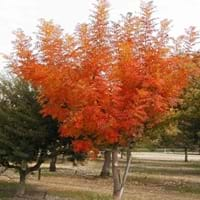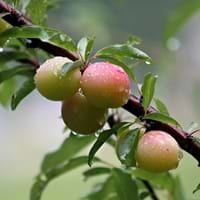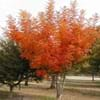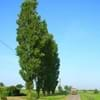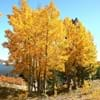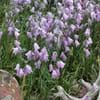Life Span
Perennial
Perennial
Origin
China
Northeastern United States, Mid-Atlantic United States, Southeastern United States, Central United States, Northwestern United States, Southwestern United States, Texas, Canada
Types
Not Available
Not Available
Number of Varieties
Not Available
Habitat
Mountains, Rocky areas
fencerows, Thickets, Upland savannas, Woodlands
USDA Hardiness Zone
6-9
3-8
Sunset Zone
4, 5, 6, 7, 8, 9, 10, 11, 12, 13, 14, 15, 16, 17, 18, 19, 20, 21, 22, 23
1a, 1b, 2a, 2b, 3a, 3b, 10
Habit
Oval or Rounded
Oval or Rounded
Flower Color
Red, Green
White
Flower Color Modifier
Bicolor
Bicolor
Fruit Color
Red, Blue, Green, Dark Blue, Black
Yellow, Red
Leaf Color in Spring
Green, Light Green
Green, Dark Green
Leaf Color in Summer
Green, Dark Green
Green, Dark Green
Leaf Color in Fall
Red, Orange, Pink
Green, Yellow green
Leaf Color in Winter
Not Available
Not Available
Plant Season
Summer, Fall
Spring, Summer
Sunlight
Full Sun, Partial Sun
Full Sun, Partial Sun
Growth Rate
Medium
Medium
Type of Soil
Clay, Loam, Sand
Clay, Loam, Sand
The pH of Soil
Acidic, Neutral, Alkaline
Acidic, Neutral, Alkaline
Soil Drainage
Well drained
Average
Bloom Time
Early Spring, Spring
Early Spring, Spring, Late Winter
Tolerances
Pollution, Drought, Soil Compaction
Cold climate
Where to Plant?
Ground
Ground
How to Plant?
Divison, Seedlings, Stem Planting, Transplanting
Seedlings, Stem Cutting
Plant Maintenance
Medium
Medium
Watering Requirements
Average Water Needs, Water once every two or three weeks, Water when top layer of soil becomes dry
Keep the ground moist but not water-logged, Needs watering once a week
In Summer
Lots of watering
Lots of watering
In Spring
Moderate
Moderate
In Winter
Average Water
Average Water
Soil pH
Acidic, Neutral, Alkaline
Acidic, Neutral, Alkaline
Soil Type
Clay, Loam, Sand
Clay, Loam, Sand
Soil Drainage Capacity
Well drained
Average
Sun Exposure
Full Sun, Partial Sun
Full Sun, Partial Sun
Pruning
Remove damaged leaves, Remove dead branches, Remove dead leaves
Prune in the late winter or spring, Remove damaged leaves, Remove dead branches, Remove dead leaves
Fertilizers
All-Purpose Liquid Fertilizer
All-Purpose Liquid Fertilizer
Pests and Diseases
Insects, Red blotch, Rodent
bees, Borers, Red blotch
Plant Tolerance
Drought, Frost
Drought
Flowers
Insignificant
Showy
Flower Petal Number
Not Available
Single
Foliage Texture
Medium
Medium
Foliage Sheen
Glossy
Matte
Attracts
Birds
Bees, Birds, Deers
Allergy
no allergic reactions
Mild Allergen
Aesthetic Uses
Beautification, Landscape Designing, Showy Purposes
Beautification, Landscape Designing, Showy Purposes
Beauty Benefits
Not Available
Not Available
Environmental Uses
Air purification
Air purification
Medicinal Uses
No Medicinal Use
Antioxidants, High cholestrol, Iron, Nutrients
Part of Plant Used
Seeds, Stem
Fruits
Other Uses
Application in Furniture, Decoration Purposes, Showy Purposes, Used in biomass, Used in Furniture
Food for animals, Used as a nutritious food item, Used as Ornamental plant, Used for its medicinal properties
Used As Indoor Plant
No
No
Used As Outdoor Plant
Yes
Yes
Garden Design
Shade Trees, Street Trees
Edible, Fruit / Fruit Tree, Screening / Wind Break, Topiary / Bonsai / Espalier, Wildflower
Botanical Name
PISTACIA chinensis
PRUNUS americana
Common Name
Chinese Mastic, Chinese Pistachio
Wild Plum
In Hindi
चीनी पिस्ता
जंगली बेर
In German
chinesische Pistazie
wild Plum
In French
pistache chinois
wild Plum
In Spanish
pistacho chino
ciruelo silvestre
In Greek
Κινέζοι Φιστίκι
Κορόμηλο
In Portuguese
Pistache chinês
Wild Plum
In Polish
Chiński Pistacje
dzikiej śliwy
In Latin
LENTISCUS Chinese
Wild Plum
Phylum
Magnoliophyta
Magnoliophyta
Class
Magnoliopsida
Magnoliopsida
Family
Anacardiaceae
Rosaceae
Clade
Angiosperms, Eudicots, Rosids
Angiosperms, Eudicots, Rosids
Tribe
Rhoeae
Not Available
Subfamily
Not Available
Amygdaloideae
Number of Species
Not Available
Importance of Chinese Pistachio and Wild Plum
Want to have the most appropriate plant for your garden? You might want to know the importance of Chinese Pistachio and Wild Plum. Basically, these two plants vary in many aspects. Compare Chinese Pistachio and Wild Plum as they differ in many characteristics such as their life, care, benefits, facts, etc. Every gardener must at least have the slightest clue about the plants he wants to plant in his garden. Compare their benefits, which differ in many ways like facts and uses. The medicinal use of Chinese Pistachio is No Medicinal Use whereas of Wild Plum is Antioxidants, High cholestrol, Iron and Nutrients. Chinese Pistachio has beauty benefits as follows: Not Available while Wild Plum has beauty benefits as follows: Not Available.
Compare Facts of Chinese Pistachio vs Wild Plum
How to choose the best garden plant for your garden depending upon its facts? Here garden plant comparison will help you to solve this query. Compare the facts of Chinese Pistachio vs Wild Plum and know which one to choose. As garden plants have benefits and other uses, allergy is also a major drawback of plants for some people. Allergic reactions of Chinese Pistachio are no allergic reactions whereas of Wild Plum have Mild Allergen respectively. Having a fruit bearing plant in your garden can be a plus point of your garden. Chinese Pistachio has no showy fruits and Wild Plum has showy fruits. Also Chinese Pistachio is not flowering and Wild Plum is not flowering . You can compare Chinese Pistachio and Wild Plum facts and facts of other plants too.
